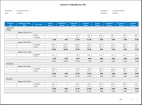Actual vs Schedule by Job
The Actual vs. Schedule by Job report shows the actual, scheduled, and projected hours and wages by job for each employee who worked that job during the selected time period. Run this report for the current pay or schedule period A repeating span of days in the schedule that is defined for administrative purposes, such as pay periods. to see how your schedule compares with actual totals and whether the projected amounts are within your budget. It is important that the totalizer is set to guarantee totals far enough into the future to cover the time period that you plan to use with this report. .
- This report is less meaningful when run against a past or future time period. When run against the past, the projected hours are always 0. When run against the future, the variance hours are always 0.
- You cannot change this report, but you can copy it and modify the copy.
- From your Report Library, click tap Run Report
- In the Select Report panel, select Timekeeping > Accrual vs Schedule by Job and click tap Select.
- In the report panel, select the parameters:
- Click Tap Select Timeframe
- Click Tap Select Hyperfind A search engine that filters and selects groups of employees through queries that specify conditions or locations (criteria).
- Click Tap New Hyperfind to create a new Hyperfind. See Hyperfind queries for more information.
- Click Tap Select Locations to open the Select locations glance (also known as a contextual callout) Provides information and actions in a dialog box for an item on the screen when the user right-clicks or taps the item.panel.
- When finished, click tap
- Click Tap Select Timeframe
- Paycodes A category of time or money that employees earn, for example, Regular Hours, Bonus, or Sick. — Click Tap more
. In the Paycodes panel, select the applicable paycodes, then click tap Apply. - Output Format — Select one of the following:
- Click Tap Run report. An In progress message displays while the report is running.
-
Click OK when the Report is Completed message appears. If you created a PDF or Excel report, a link appears at the bottom of the Report Library. If you created an interactive report, the report opens in a new tab automatically. The report opens in a new window.
The report contains the following columns:
- Worked Job
- Employee Name (ID) — Last name, first name with the employee's ID
- Paycode — The paycode that is associated with the hours and wages.
- Actual Hours — The number of hours that the employee has worked within the specified paycode and on the specified job.
- Scheduled Hours — The number of hours that the employee is scheduled to work within the specified paycode and on the specified job.
- Projected Hours — The number of hours that the employee is projected to work within the specified paycode and on the specified job.
- Variance Hours — If all of the selected time period is in the past, then this column reports scheduled hours minus actual hours. If any of the selected time period is in the present or future, then this column reports scheduled hours minus projected hours.
- Actual, Scheduled, Projected, and Variance Wages — Same as Actual, Scheduled, Projected, and Variance Hours, but the amount of wages instead of number of hours.
If applicable, the total number of employees who are not totalized also appears as well as the employee's name (last, first) and ID.
